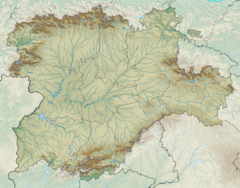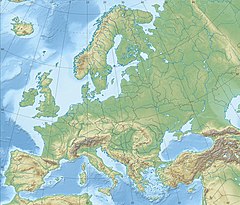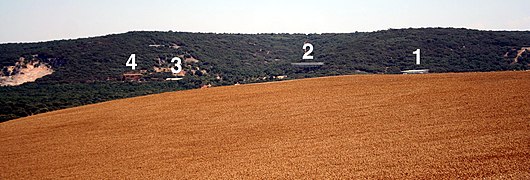| UNESCO World Heritage Site | |
|---|---|
 Karst cave in Atapuerca Karst cave in Atapuerca | |
| Official name | Archaeological Site of Atapuerca |
| Location | Atapuerca, Burgos |
| Part of | Atapuerca Mountains |
| Criteria | Cultural |
| Reference | 989 |
| Inscription | 2000 (24th Session) |
| Coordinates | 42°21′09″N 3°31′06″W / 42.35250°N 3.51833°W / 42.35250; -3.51833 |
   | |
The archaeological site of Atapuerca is located in the province of Burgos in the north of Spain and is notable for its evidence of early human occupation. Bone fragments from around 800,000 years ago, found in its Gran Dolina cavern, provide the oldest known evidence of hominid settlement in Western Europe and of hominid cannibalism anywhere in the world.
It was designated a World Heritage Site in 2000.
Discovery of the site
The archaeological significance of this part of the province of Burgos became increasingly apparent in the 20th century as the result of the construction of a metre-gauge railway (now disused) through the Atapuerca Mountains. Deep cuttings were made through the karst geology exposing rocks and sediments of features known as Gran Dolina, Galería Elefante and Sima de los Huesos.
The subsequent excavation of 1964 under the direction of Francisco Jordá Cerdá succeeded with the discovery of anthropogenic artifacts and human fossils from a broad time range (early humans, hunter-gatherer groups, Bronze Age occupants). Further excavations followed, and interdisciplinary work has been undertaken by several teams, led by Emiliano Aguirre from 1978 to 1990 and later jointly by Eudald Carbonell, José María Bermúdez de Castro and Juan Luis Arsuaga. These have confirmed the continuous human occupation of the site. In July 2020 two quartzite stones were discovered, dating to 600,000 years ago, a find which filled in a gap in the evidence for human occupation of the site over a timeline of 1,200,000 years.
Protection and access
The site was designated a UNESCO World Heritage Site, under the name, Archaeological Site of Atapuerca. The site is also protected at national level (as a Zona Arqueológica, a category of Bien de Interés Cultural on the heritage register) and at regional level (Castile and León has designated the Sierra de Atapuerca an Espacio cultural).

The regional designation of Espacio cultural is intended to allow sustainable tourism in the local villages. There is a Site Access Centre (CAYAC) in Ibeas de Juarros. There is also an Experimental Archaeology Centre (CAREX) in the village of Atapuerca. Finds are shown at the Museum of Human Evolution in the city of Burgos.
Excavation sites


Portalón de Cueva Mayor (1910 to present)
The combined work of archaeologists Jesús Carballo (1910 to 1911), Geoffrey Clark (1971), José María Apellániz (1973 to 1983) and the current team of Juan Luis Arsuaga accounts for the documentation of the excavation sequence of ceramic objects from all relevant sediment layers since the Neolithic.
Trinchera Galería (1978 to present)
Among numerous faunal and floral fossils, a jaw fragment was found during the 1970s and a skull fragment in 1995, which both belong to Homo heidelbergensis. They date to between 600,000 and 400,000 years BP.
Trinchera Dolina (1981 to present)
The Gran Dolina (also Trinchera Dolina, English: Dolina trench) site is a huge cavern, which has been excavated since September 1981. Its sediments were divided into eleven stratae (TD-1 to TD-11)
- TD-11: Mousterian tools found.
- Level TD-10 is presumed to have been a Homo heidelbergensis camp with tools and bison fossils.
- Level TD-8, accessible since 1994, contained remarkable carnivore fossils.
- In level TD-7, a bovine leg in anatomical position was recovered in 1994.
- TD-6 (Aurora stratum): From 1994 on, over 160 bone fragments of at least eleven hominids were found, between 850,000 and 780,000 years old, which makes them at least 250,000 years older than any other hominid yet discovered in Western Europe. More than 30% of the bones have manipulation marks that suggest cannibalism. Classification of these remains is still being debated; suggestions range from Homo erectus to Homo heidelbergensis and Homo antecessor. Some researchers, who are familiar with the stratigraphic material of Gran Dolina, argue that Homo antecessor may be the ancestor of Homo heidelbergensis, who in turn gave rise to Homo neanderthalensis. Retouched flake and core stone tools were also found.
- The hominid remains show unmistakable signs of having been butchered and consumed in the same way as animals whose bones were also found in this stratum. All bones belonged to young individuals, ranging from infancy to late teenhood. A study of this case considers it an instance of "nutritional" cannibalism, where individuals belonging to hostile or unrelated groups were hunted, killed, and eaten much like animals. Based on the placement and processing of human and animal remains, the authors conclude that cannibalism was likely a "repetitive behavior over time as part of a culinary tradition", not caused by starvation or other exceptional circumstances. They suggest that young individuals (more than half of which were children under ten) were targeted because they "posed a lower risk for hunters" and because this was an effective means for limiting the growth of competing groups.
- Level TD-5 is assumed to have been a carnivore den.
- In TD-4 (dated to 780,000 BP), four lithic pieces were found during the 1991 excavation and several remnants of Ursus dolinensis, a sparsely described bear species.
- At the lowest levels (TD-1 and TD-2), no fossils were found.
Sima de los Huesos (1983 to present)
Sima de los Huesos (Pit of Bones) accounts for the greatest number of valuable scientific discoveries and knowledge acquired with far-reaching implications. This site is located at the bottom of a 13 m (43 ft) deep shaft, or "chimney", accessible via the narrow corridors of the Cueva Mayor.
Since 1997, the excavators have located more than 5,500 human skeletal remains deposited during the Middle Pleistocene period, at least 350,000 years old, which represent 28 individuals of Homo heidelbergensis (also classified as early Neanderthals). Associated finds include Ursus deningeri fossils and a hand axe called Excalibur. It has received a surprisingly high degree of attention, and a number of experts support the hypothesis that this particular Acheulean tool made of red quartzite seems to have served as a ritual offering, most likely for a funeral. The idea sparked a renewal of the disputed evolutionary progress and the stages of human cognitive, intellectual and conceptual development. Ninety percent of the known Homo heidelbergensis fossil record have been obtained at the site. The fossil bone pit includes:
- The complete cranium, Skull 5, nicknamed Miguelón, the fragmented cranial remains of Skull 4, nicknamed Agamenón and Skull 6, nicknamed Rui (a reference to the medieval military leader El Cid).
- A complete pelvis (Pelvis 1), humorously nicknamed Elvis
- Mandibles, teeth, a lot of postcranial bones (femora, hand and foot bones, vertebrae, ribs, etc.)
- Remains of a child with craniosynostosis were found and dated to 530,000 BP. The find was considered to provide evidence for caring of individuals with disabilities in early human populations.
- Mitochondrial DNA (mtDNA) from a 400,000 year old femur has been sequenced, the oldest hominin mtDNA recovered as of 2013. The mtDNA was found to be closer to the mtDNA of Denisova hominins than to the mtDNA of Neanderthals.
- In 2016, nuclear DNA analysis results determined the Sima hominins to be Neanderthals and not Denisova hominins, and the divergence between Neanderthals and Denisovans predates 430,000 years.
- In 2019, analysis of Neanderthal teeth found at Sima de los Huesos indicates that modern humans and Neanderthals separated from a common ancestor more than 800,000 years ago.
- In 2020, analysis of tooth enamel of hominids found at the sites of Sima del Elefante, Gran Dolina-TD6 and Sima de los Huesos concluded that Atapuerca hominids grew faster than modern humans.

Some excavators have stated that the concentration of bones in the pit allows the suggestion of a traditional burial culture among the cave's inhabitants. A competing theory cites the lack of small bones in the assemblage and suggests that the fossils were washed into the pit by non-human agents.
Sima del Elefante (1996 to present)
According to José María Bermúdez de Castro, co-director of research at Atapuerca, the Sima del Elefante findings support "anatomical evidence of the hominids that fabricated tools more than one million years ago", which may have been the earliest among Western European hominids. The first discovery in June 2007 was a tooth, followed by a fragment of a 1.2 million-year-old jawbone (mandible) and a proximal phalanx in 2008. In July 2022, archaeologists announced the discovery of a 1.4 million-year-old jawbone (maxilla) included a tooth of a hominid. The paleoanthropoligist Eudald Carbonell, who serves as co-director of the excavations at the Archaeological Site of Atapuerca, hypothesizes that the aforementioned jawbone belongs to a specimen of Homo erectus. Other researchers suggest it may have come from Homo antecessor, an early species of human. It located about two meters deeper in the soil than the fossils found in 2008.
Cueva del Mirador (1999 to present)
This site provides information on the earliest local farmers and herders of the late Neolithic and Bronze Age.
Orchids Valley (2000 to 2001) and Hundidero (2004 to 2005)
Stone tools of the Upper Paleolithic have been extracted from this locality.
Cueva fantasma (2017 to present)
Homo neanderthalensis craneal fossil (no context) and lithic tools at located here.
Galería de las estatuas (2017 to present)
Mousterian tools with Homo neanderthalensis bones and DNA remains.
See also
References
- ^ White, Tim D. (2006). "Once Were Cannibals". Evolution: A Scientific American Reader. University of Chicago Press. pp. 342–343. ISBN 978-0-226-74269-4. Retrieved 27 April 2023.
- Domínguez, Nuño (23 July 2020). "Hallada una nueva presencia humana en Atapuerca hace 600.000 años". El País (in Spanish). Prisa. Retrieved 23 July 2020.
- G.G.U. (3 July 2020). "Atapuerca completa su secuencia evolutiva". Diario de Burgos (in Spanish). Retrieved 23 July 2020.
- "Archaeological Site of Atapuerca – UNESCO World Heritage Centre". Whc.unesco.org. Retrieved January 26, 2017.
- "Landforms And Geomorphological Processes In The Duero Basin. Pleistocene Geoarcheology Of Ambrona And Atapuerca Sites" (PDF). Geomorfologia.es. Archived from the original (PDF) on September 12, 2016. Retrieved January 27, 2017.
- "MEMORIA del Espacio Cultural "Sierra de Atapuerca"" (PDF). Jcyl.es. Retrieved January 26, 2017.
- "Visiting the Site Access Centre (CAYAC)". Atapuerca Foundation.
- ^ Carbonell, Eudald; Cáceres, Isabel; Lozano, Marina; Saladié, Palmira; Rosell, Jordi; Lorenzo, Carlos; Vallverdú, Josep; Huguet, Rosa; Canals, Antoni; Bermúdez de Castro, José Marı́a (2010). "Cultural Cannibalism as a Paleoeconomic System in the European Lower Pleistocene". Current Anthropology. 51 (4): 543–545. doi:10.1086/653807. JSTOR 10.1086/653807.
- Carbonell et al. 2010, pp. 539–540, 547.
- Carbonell et al. 2010, p. 548.
- "Prehistoric skull with puncture wounds could be world's first murder mystery". Msn.com. Retrieved January 26, 2017.
- Greenspan, Stanley (2006-02-07). How Symbols, Language, and Intelligence Evolved from Early Primates to Modern Human. Hachette Books. ISBN 978-0-306-81449-5.
- ^ Meyer, Matthias; Arsuaga, Juan-Luis; de Filippo, Cesare; Nagel, Sarah; Aximu-Petri, Ayinuer; Nickel, Birgit; Martínez, Ignacio; Gracia, Ana; de Castro, José María Bermúdez; Carbonell, Eudald; Viola, Bence; Kelso, Janet; Prüfer, Kay; Pääbo, Svante (March 2016). "Nuclear DNA sequences from the Middle Pleistocene Sima de los Huesos hominins". Nature. 531 (7595): 504–507. Bibcode:2016Natur.531..504M. doi:10.1038/nature17405. PMID 26976447. S2CID 4467094.
- Gómez-Robles, Aida (2019-05-03). "Dental evolutionary rates and its implications for the Neanderthal–modern human divergence". Science Advances. 5 (5): eaaw1268. Bibcode:2019SciA....5.1268G. doi:10.1126/sciadv.aaw1268. ISSN 2375-2548. PMC 6520022. PMID 31106274.
- ^ Callaway, Ewen (March 2016). "Oldest ancient-human DNA details dawn of Neanderthals". Nature. 531 (7594): 286. Bibcode:2016Natur.531..296C. doi:10.1038/531286a. PMID 26983523. S2CID 4459329.
- "Excalibur, the rock that may mark a new dawn for man". The Guardian. January 9, 2003. Retrieved January 26, 2017.
- Gracia, Ana; Arsuaga, Juan Luis; Martínez, Ignacio; Lorenzo, Carlos; Carretero, José Miguel; Bermúdez de Castro, José María; Carbonell, Eudald (21 April 2009). "Craniosynostosis in the Middle Pleistocene human Cranium 14 from the Sima de los Huesos, Atapuerca, Spain". Proceedings of the National Academy of Sciences of the United States of America. 106 (16): 6573–6578. doi:10.1073/pnas.0900965106. PMC 2672549. PMID 19332773.
- Callaway, Ewen (December 2013). "Hominin DNA baffles experts". Nature. 504 (7478): 16–17. Bibcode:2013Natur.504...16C. doi:10.1038/504016a. PMID 24305130.
- Gómez-Robles, Aida (May 2019). "Dental evolutionary rates and its implications for the Neanderthal–modern human divergence". Science Advances. 5 (5): eaaw1268. Bibcode:2019SciA....5.1268G. doi:10.1126/sciadv.aaw1268. PMC 6520022. PMID 31106274.
- Modesto-Mata, Mario; Dean, M. Christopher; Lacruz, Rodrigo S.; Bromage, Timothy G.; García-Campos, Cecilia; Martínez de Pinillos, Marina; Martín-Francés, Laura; Martinón-Torres, María; Carbonell, Eudald; Arsuaga, Juan Luis; Bermúdez de Castro, José María (December 2020). "Short and long period growth markers of enamel formation distinguish European Pleistocene hominins". Scientific Reports. 10 (1): 4665. Bibcode:2020NatSR..10.4665M. doi:10.1038/s41598-020-61659-y. PMC 7069994. PMID 32170098.
- "'First west Europe tooth' found". BBC News. 2007-06-30. Retrieved 2021-10-07.
- Hopkin, Michael (26 March 2008). "Fossil find is oldest European yet". Nature: news.2008.691. doi:10.1038/news.2008.691.
- López-Valverde, A; López-Cristiá, M; R, Gómez de Diego (2012). "Europe's oldest jaw: evidence of oral pathology". British Dental Journal. 212 (5): 243–245. doi:10.1038/sj.bdj.2012.176. PMID 22402544. S2CID 22346193.
- "Atapuerca completa el puzle con el "Homo erectus": "Es seguro, no hay dudas"". www.larazon.es (in Spanish). 2023-01-29. Retrieved 2023-03-06.
- Jennifer Nalewicki (2022-07-17). "1.4 million-year-old jawbone may belong to oldest known human relative in Europe". livescience.com. Retrieved 2022-08-04.
- Domínguez, Nuño (2022-07-08). "Hallada en Atapuerca la cara del humano más antiguo de Europa". El País (in Spanish). Retrieved 2022-08-04.
External links
- Official Web Page of the Atapuerca UCM-ISCIII Research Group
- Fundación Atapuerca
- Atapuerca: el observatorio de la Prehistoria on Centro Virtual Cervantes
- Yacimiento Arqueológico de Atapuerca on UNESCO
- American Museum of Natural History-Atapuerca